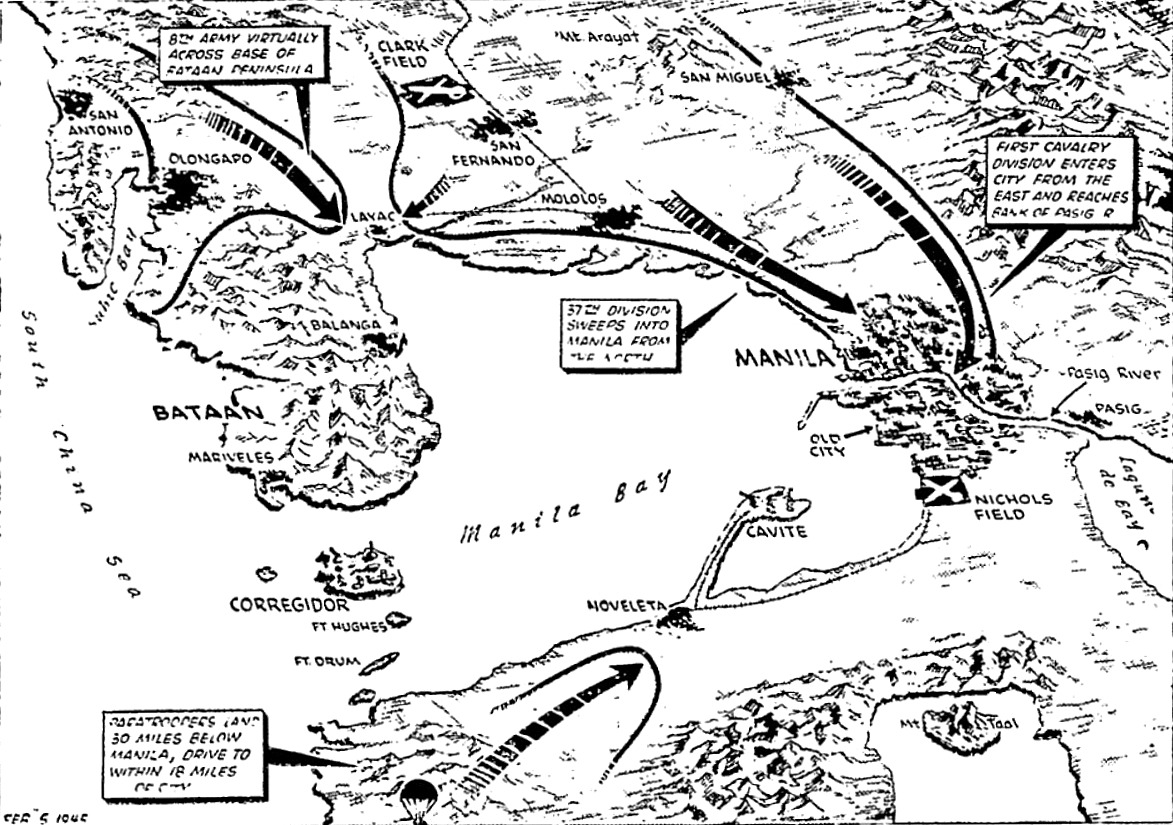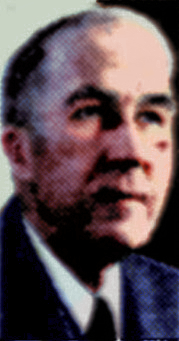The Pittsburgh Press (February 6, 1945)
JAPS IN MANILA CUT OFF
City’s fall proclaimed – ‘On to Tokyo!’ slogan of MacArthur now
Bataan Peninsula sealed – Americans prepare for assault on Corregidor
MANILA, Philippines (UP) – Three U.S. divisions today encircled fanatically resisting Jap remnants in Manila.
The action virtually completed the liberation of the Philippines and setting the stage for the next phase of the march on Tokyo.
Gen. Douglas MacArthur officially proclaimed the fall of Manila, capital of the Philippines and largest city yet liberated in the Pacific war, and said the motto of his command now was: “On to Tokyo!”
He said the “complete destruction” of the doomed enemy garrison of Manila was imminent and revealed that another 1,350 U.S. and Allied war prisoners and civilian internees had been freed yesterday with the capture of ancient Bilibid Prison.
Other U.S. forces avenging the bitter defeats of 1942 sealed off Bataan Peninsula and were believed preparing for an early assault on Fort Corregidor in Manila Bay.
Gen. MacArthur said in a statement accompanying his daily communiqué:
The fall of Manila marks the end of one great phase of the Pacific struggle and set the stage for another.
With Australia safe, the Philippines liberated, and the ultimate redemption of the East Indies and Malaya thereby made a certainty, our motto becomes, “On to Tokyo!”
Writing off the eventual loss of Manila, Jap propagandists said that the coming of the Americans to Manila was “exactly what our side waited for, and our bleeding tactics will now enter the positive stage.”
Drive from south
The 11th Airborne Division completed the stranglehold on the battered Jap garrison in Manila by smashing into the city from the south yesterday after an overnight dash of 35 miles.
The 37th Infantry Division, pouring into the capital from the north, and the 1st Cavalry Division, from the east, linked up in the heart of Manila and cleared all of the city north of the Pasig River with the exception of scattered groups of snipers.
The Japs blew up the Quezon and Ayala Bridges across the broad Pasig as they fell back into the southern half of Manila for a last stand. Two other bridges remained intact, however, and may have been captured by the Americans.
Explosions shake ground
Jap demolition squads continued their destructive work in southern Manila, working feverishly against their own imminent destruction. Numerous fires cast a heavy pall of smoke over the city and explosions shook the ground at frequent intervals.
With the 11th Airborne Division’s thrust into southern Manila however, the enemy garrison could be considered “hopelessly trapped,” Gen. MacArthur said.
The 37th Infantry Division captured Bilibid Prison in the northern half of Manila yesterday, releasing more than 800 war prisoners and about 550 additional civilian internees, including women and children.
5,500 prisoners rescued
That brought to more than 5,500 the number of Allied prisoners rescued in the past week, including those at the Santo Tomas University concentration camp in Manila and the Cabanatuan prison camp in Central Luzon.
Most were Americans, but the number also included a scattering of British, Australians, Dutch and other Allied nationals. Gen. MacArthur said the names of those rescued at Santo Tomas and Bilibid would be released as soon as they have been tabulated, probably a matter of several days.
“Every facility of the Armed Forces is being devoted to the care and attention of those who have been rescued,” Gen. MacArthur’s communiqué said.
Hospital move in
Food trucks were revealed to have reached Santo Tomas only a few hours after 1st Cavalry Division spearheads freed the camp. Huge mobile hospitals rolled into Manila today to care for medical cases.
Bataan Peninsula, where the Americans made a bloody stand in 1942 before retiring to Corregidor, was sealed off by a junction of the Eighth Army’s 11th corps and the Sixth Army’s 14th Corps at Dinalupihan, 37 miles northwest of Manila.
With U.S. forces in control of all roads leading into Bataan, the way was blocked for any prolonged Jap stand on the peninsula.
Corregidor bombed
Continuing to prepare the way for an attack on Corregidor, the largest force of Liberators yet struck the island in two raids Saturday. Corregidor must be captured before Manila Bay can be opened to American shipping.
To the north, the First Corps seized most of San Jose, 80 miles above Manila and only 37 miles from the east coast of Luzon, in a drive that cut the main road to the Balete Pass and Cagayan Valley.
More dead on Leyte
Fierce fighting continued in the Munoz sector, seven miles southwest of San Jose, where 25 enemy tanks, many trucks, pillboxes and artillery pieces have been destroyed. Units north of San Jose engaged the Japs in Pupao and advance five miles along the Villa Verde Trail into the Caraballo Mountains.
On Leyte in the central Philippines, U.S. troops counted an additional 733 enemy dead or prisoners.
U.S. patrol planes in the China Sea sank two small freighters off Amoy on the China coast, bombed and strafed parked aircraft at Swatow Airdrome, started fires at Takao, Formosa, and sank a fuel-laden vessel northwest of Formosa.
Bilibid prisoners saved from fire
MANILA, Philippines (UP) – A caravan of U.S. jeeps and trucks roared through the sniper-infested streets of Manila last night to rescue 1,003 prisoners and internees from Bilibid Prison when Jap fires raging on three sides, threatened to engulf the former federal penitentiary.
Every man in the 37th Infantry Division was turned out to evacuate the men, women and children of Bilibid.
Military authorities said the evacuation was completed just in time. Jap mortar fire had been dropping in the civilian and prisoner of war compounds all day. Shortly after the prison was cleared, Jap machine-gun fire started to rake the prison yard.
Those evacuated were 639 U.S. prisoners of war and 465 civilian internees. The civilian group included approximately 392 Americans, 71 British, one Mexican and one Chinese. There were 214 women, 169 men and 82 children, a dozen of whom had been born at the Baguio Prison Camp.

